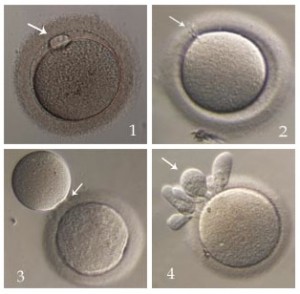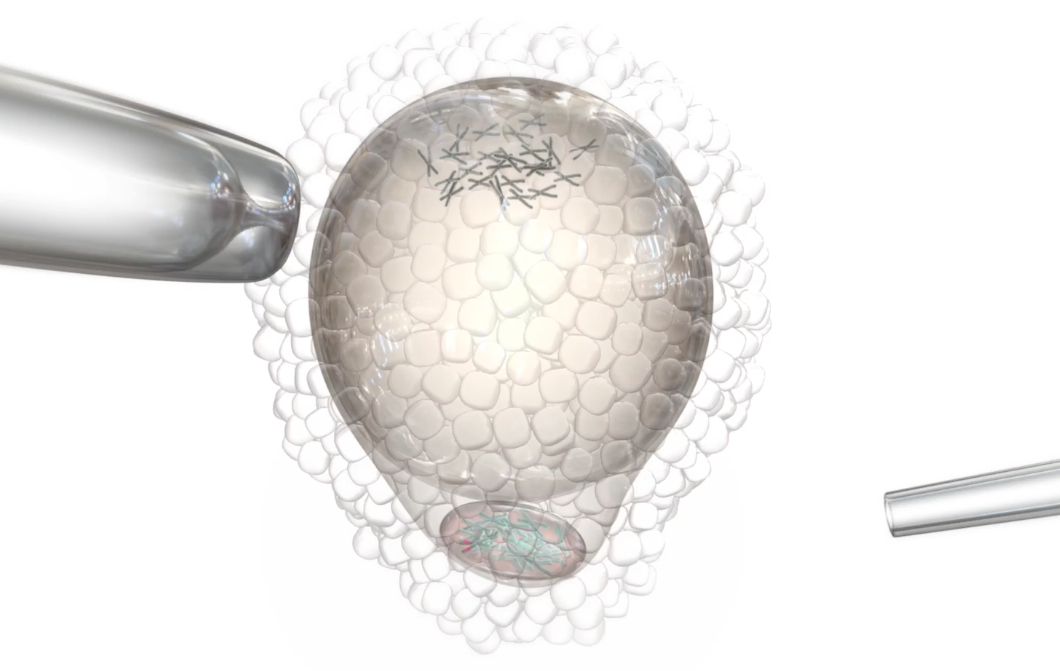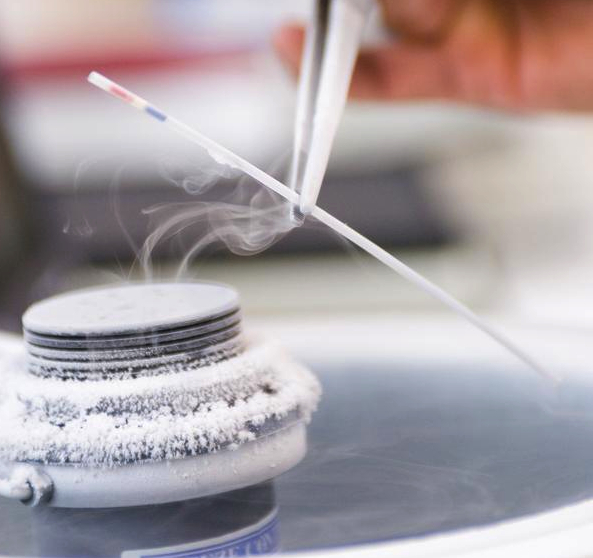Researchers are now intending to seek permission from the Human Fertilization and Embryology Authority (HFEA) to fertilize the eggs in order to test whether they are viable. Should such a study be successful, it would represent a breakthrough in fertility research and could open the door to greatly enhanced fertility for many women.
Tag: eggs
Genetic Testing on Eggs Prior to Freezing
Eggs are more prone to genetic abnormalities as a woman ages. These abnormalities lead to increased incidences of infertility, miscarriage and birth defects especially in women over 38 years of age. Egg freezing is a method that suspends egg aging. Since the genetic status of an egg cannot be determined solely on appearance, methods to evaluate eggs using genetic probes have developed and recently tested.
The egg discards DNA at two different times during its development, ovulation and fertilization. The reason for this is to reduce the number of chromosomes to 23 in order to match the 23 chromosomes delivered by the sperm. The discarded DNA (in the form of excess chromosomes) is jettisoned outside of the egg as a small, round pocket called the polar body. Removal of the polar body (biopsy) can provide useful information about the genetic status of the egg. For example, if 23 chromosomes are found in the polar body, the presumption is that a normal count of 23 chromosomes remains in the egg. In contrast, if a number other than 23 is found in the polar body, it implies that an abnormal count remains in the egg and suggests that the egg and ensuing embryo will be genetically abnormal. Testing of the polar body using modern genetic techniques such as Comparative Genomic Hybridization (CGH) or Array-CGH, allows identification of abnormal eggs and can thus help determine the number of genetically normal eggs a woman has to freeze.
However, there are several important limitations to this technology. First, CGH and Array-CGH are still considered experimental, with very little clinical data available. Most clinical data is based on young egg donors and does not reflect the genetic status of eggs from women in their late 30’s. Second, embryos may be genetically abnormal due to mistakes contributed by the egg at the time of the first polar body formation or the second polar body formation; or mistakes contributed by the sperm at the time of fertilization. Therefore, assessing only the first polar body by no means guarantees that a normal embryo will derive. Third, and perhaps most concerning, is the lack of research regarding the effects of biopsying an egg prior to freezing.
We recently completed a small clinical trial wherein we performed polar body biopsy on eggs prior to freezing. We found a high degree of egg damage. The panel of microscopic pictures above demonstrate these changes: the first picture is a normal egg with an intact first polar body (Photo #1); the next picture is an egg after the polar body was removed (Photo #2); the next two pictures show a biopsied egg after freezing and thawing demonstrating egg contents (Photos #3 & #4) extruding through the biopsy slit.  These changes were found on multiple eggs from different patients. These eggs had to be discarded. In addition, many other eggs demonstrated abnormal chromosome segregation after fertilization, and none of the patients achieved a pregnancy.
These changes were found on multiple eggs from different patients. These eggs had to be discarded. In addition, many other eggs demonstrated abnormal chromosome segregation after fertilization, and none of the patients achieved a pregnancy.
At the current time we do not recommend polar body biopsy of eggs prior to freezing until further studies on effectiveness and safety are available.
Why aren’t more young cancer patients preserving their fertility?
The answer to the question above, according to a recent study in the journal Cancer, is that too often, young women who have cancer simply don’t understand their options when it comes to preventing the loss of their chance to have a child or more children. According to Reuters Health, which reported on the new research late last month, only one in every 25 women who was diagnosed with one of five types of cancer since the early 1990s opted to freeze eggs or embryos prior to cancer treatment — in spite of the fact that 47 to 63 percent said they wanted to have a child or children.
This finding is the result of research on 1,000 women in California ages 18 to 40 who’d been diagnosed with cancer between 1993 and 2007. Sixty-one percent of the women said their doctors talked to them about how cancer treatment could affect their chances of having a baby and how they could preserve their fertility — which means that 39 percent of patients didn’t get that guidance. Just four percent of those who got counseling about fertility preservation took action – by freezing eggs or embryos before, say, they underwent chemotherapy or radiation.
The research found, not surprisingly, that the women who had been counseled about how to save their fertility, or minimize the impact of treatment on their ability to conceive, were much less likely to feel regret later, versus the women who’d never talked to a doctor about their options for having a child or children later before undergoing treatment. Though the most recent data is still five years old, there’s reason to believe we still have a bit to go before all young women who get a cancer diagnosis are aware of all their options for having a family as they consider the treatment plan that’s right for them.
Study: Egg Donors Remain Fertile After Procedure
Some experts question whether hormonally stimulating the ovaries — which makes them produce extra eggs — and removing those eggs from a healthy, young woman could later increase her chance of infertility, but others contend there are no serious long-term risks.
How Eggs Fight Off Tardy Sperm Intruders
During human (or any mammalian) fertilization, if more than one sperm manages to get inside an egg, there are typically no survivors. A violent competition between the two sperm brings the whole kit and caboodle to a tragic end.
What is Egg Freezing
What Is Egg Freezing?
Egg freezing is a breakthrough technology that allows women to freeze and store their eggs until a pregnancy is desired. At that time, the eggs are thawed, fertilized and transferred to the uterus as embryos.
Who May Benefit
Many women today are postponing childbearing because they are focused on a career, are returning to school, or because they simply haven’t met the right person. For these women, egg freezing is revolutionary, not just in its technology, but in the life choices it allows them to make.
Over 50,000 reproductive-aged women are diagnosed with cancer each year in the United States. Surgery, chemotherapy and radiation treatments typically lead to infertility by destroying the eggs. While options vary depending on age, type of cancer and cancer-treatment plan, egg freezing can provide these women the opportunity to preserve their fertility.
And finally, egg freezing can be useful for individuals with religious or moral objections to storing frozen embryos that remain following a routine IVF cycle.
How Egg Freezing Works
It takes approximately four to six weeks to complete the egg freezing cycle, which follows the same protocol as IVF. This includes birth control pills and self-administered hormone injections to stimulate the ovaries. Eggs are retrieved and are frozen immediately following retrieval. When embryo transfer is desired, the eggs are thawed, injected with a single sperm to achieve fertilization, and transferred to the uterus as embryos.
Storage
We recommend that at least ten eggs be stored for each pregnancy attempt. For women under thirty-eight years of age, we normally harvest ten to twenty eggs per cycle. Based on our success with embryo freezing, we believe that long-term storage of frozen eggs is possible.
Success Rates
Our most recent frozen egg pregnancy rates are among the highest in the country – approximately 50% with the vitrification method. This figure is well above the national average for frozen embryos. Furthermore, we anticipate continued success and improvement in these rates with our dedication to ongoing research in the field.
Safety
To date, approximately 1500 babies have been born worldwide from frozen eggs. Among these births, the rate of birth defects and chromosomal defects has been no higher than that which we see in the general population.
Cost
The cost of egg freezing is approximately $10,000 – $15,000 plus annual storage fees.
What is IVF?
Technically, “in vitro fertilization” only refers to the process of fertilizing an egg outside the body. However, the term IVF is generally used to describe the entire treatment cycle. This involves three phases:
Phase 1 – Egg RecruitmentThe patient receives a series of hormone injections over a period of several weeks. These hormones stimulate a number of her existing eggs to develop and become ready for fertilization. The eggs are then retrieved through the vaginal wall using a needle in a quick, outpatient procedure.
Phase 2 – Egg Fertilization
Fresh or frozen sperm can be used to fertilize several of the patient’s eggs in an IVF dish. The eggs are observed to ensure that fertilization is successful. Then, the embryos are allowed to grow for 3-5 days. At this point, they are ready for transfer back into the patient’s body. Excess embryos can be frozen for later use.
Phase 3 – Embryo Transfer
A fertilized embryo is delivered into the patient’s uterus via a narrow, flexible catheter. Rather than simply being released into the womb, the embryo is precisely placed on the wall of the uterus to increase its chances of survival. Within two weeks, a pregnancy test can be used to confirm successful implantation. Progesterone hormone treatment is continued through the first trimester. This keeps the lining of the uterine wall thick enough to nurture the implanted embryo properly.
Some patients achieve a pregnancy after just one round of in vitro fertilization while others require multiple treatment cycles. Additional options may be explored for patients who do not respond to IVF.
A Gamete Matchmaker
During fertilization, some pairings of mussel sperm and eggs work better than others—but how do the best couples find one another in the open ocean? New research, published online Tuesday (March 20) in Proceedings of the Royal Society B: Biological Sciences, raises that possibility that chemicals released by eggs may help sperm find not just any eggs, but the ones that will have the most successful fertilizations.
In Vitro Babies Denied US Citizenship
The U.S. State Department says a child born outside the USA to an American cannot receive citizenship until a biological link with at least one parent is established. That link does not exist if an infertile woman uses donor eggs at a clinic to conceive.
Freezing Eggs, Embryos Poses Legal Concerns
Canada’s fertility clinics are offering growing numbers of women the chance to freeze their biological clocks by put-ting eggs – and, in some cases, embryos – into cold storage until they’re ready to have a baby


